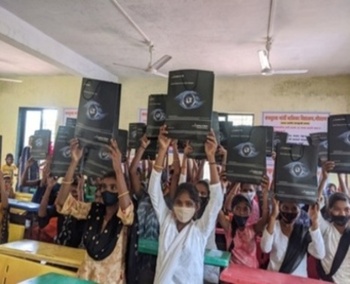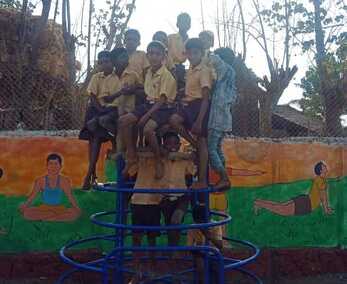Lighting Up Young Futures: Why Schools Need Reliable Power

Across India, Thousands of rural students still sit in poorly lit classrooms with broken fans and no access to digital tools. This is a common sight in tribal, remote, and hilly terrains. In these areas, schools continue to function without consistent access to electricity. In the absence of reliable power for schools, everything from student learning to teacher motivation and parental trust suffers. Children lose focus in the heat, and digital labs remain unused. Even the basics like safe toilets, drinking water pumps, and midday meals begin to break down.
According to UDISE+ 2021–22, over 90% of Indian schools are “electrified,” but this number hides a worrying truth. Many schools have no functional wiring, no supply during school hours, or infrastructure that’s simply unusable. The real number of schools that benefit from electricity in rural schools in India is much lower.
That’s where NGOs like Project Chirag are stepping in. By introducing solar energy projects for school students, they are turning dysfunctional buildings into spaces of dignity, comfort, and aspiration.
The True Importance of Power Supply in Education
The importance of power supply in education cannot be overstated. It’s not just about switching on a fan or charging a laptop; it’s about ensuring children stay in school, learn better, and dream bigger.
Here’s how access to electricity in rural schools in India changes everything:
- Improved classroom comfort: With fans and lights, students concentrate longer and miss fewer days
- Teacher performance goes up: When teachers have access to basic teaching tools and digital content, delivery improves
- Digital learning becomes possible: Audio-visual content, smart classrooms, and computer education become standard, not aspirational
- Nutrition and hygiene improve: Toilets and kitchens rely on water, which in turn depends on powered pumps
- Retention and enrolment rise, especially for girls: Safe, lit, and hygienic schools directly encourage more families to send their daughters
Reliable electricity is not a technical upgrade. It’s a moral and educational necessity, one that touches every aspect of school life. And when powered by solar, it becomes a clean, scalable, and sustainable solution.
Solar Energy Projects for School Students: What the Ground Says
Solar-powered schools offer a uniquely effective way to bridge the rural-urban learning gap. They remove dependency on failing grid connections and bring in power that’s consistent, cost-effective, and climate-resilient.
Let’s look at how this works in practice through three success stories from Project Chirag’s recent work:
- ZP Upper Primary School Savroli
Through the Integrated School Development Project, ZP Upper Primary School in Savroli gained access to solar power, a computer lab, and a community space. The new infrastructure enabled holistic programs in music, nutrition, and performing arts, enhancing overall student well-being. In the second phase, solar power was extended to all classrooms, along with improvements in water and sanitation facilities.
- Haite Memorial Friendship School, Mauldam, Assam
This school serves 201 children from 10 villages. Due to its isolation, the school faced issues like dark classrooms and a lack of power. The installation of a 5 kW hybrid solar system transformed learning conditions, enabling well-lit classrooms, computer education, and even adult e-literacy. The solar power also provided vital connectivity and emergency charging during floods.
- Pingeman, Maharashtra
Pingeman’s village school benefited from a solar setup that not only lit classrooms but also powered digital learning tools, a big leap for a region previously operating without consistent electricity. Students who once studied by kerosene lamps could now engage with educational content in safer, healthier environments.
Across these villages, reliable power reshaped learning outcomes, restored teacher morale, and created safer, more inclusive spaces for children, especially girls. As highlighted in Project Chirag’s fieldwork, these solar-powered schools are proof that sustainable development begins at the grassroots, with light, learning, and long-term impact.



From Classrooms to Community Impact: How Reliable Power Drives Holistic Rural Change
The transformation doesn’t end at the school gate. When schools get reliable power, the effects ripple through the entire village quietly but powerfully. What begins as an intervention in a classroom often turns into a catalyst for sustainable village development.
- Children Learn Better, and Stay Longer
According to the ASER 2022 Report, while school enrolment in rural India remains above 96%, learning levels and attendance are deeply affected by school infrastructure. Power-backed schools help reverse this. With cooler classrooms and access to engaging tools, students stay focused and motivated.
- Teachers Feel Equipped and Energised
The UNESCO State of Education Report (2022) found that teacher attrition in rural India is partly tied to poor teaching conditions. In electrified schools, teachers are not only more comfortable but also more empowered. They can show videos, use smart boards, and plan richer lessons.
- Parents Reconnect with the School System
In villages where schools had previously failed, electrification became a visible sign of revival. Parents who had once pulled children out now bring them back. Village development success stories often begin with this shift in belief.
- Girls Feel Safer and Stay in School
From functioning toilets to safe dorms, solar energy projects for school students, especially girls, create environments where they can learn without fear. This is critical in reducing dropout rates and empowering the next generation of women leaders from rural India.
- The Entire Village Learns to Dream
When a school is powered, the entire community benefits. In villages, schools can become a venue for evening activities, teacher meetings, and cultural events. That’s the mark of social development in villages: the school becomes a hub of hope, not a neglected building.
Let’s Scale This: How You Can Support Reliable Power for Schools?
At Project Chirag, solar energy projects for school students are more than an initiative; they’re a movement. And you can help grow it.
There is space to collaborate.
You can:
- Sponsor solar installations for one or more schools
- Support the Integrated School Development program
- Contribute to digital learning tools powered by clean energy
Advocate for sustainable village development by amplifying these stories.
Reliable power for schools is not optional. It’s the baseline of justice in education. Let’s make it the norm, not the exception. Support rural development with Project Chirag.




